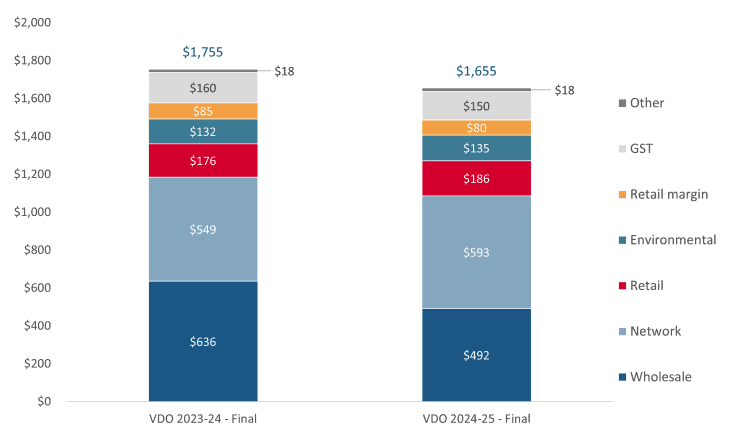Why the VDO matters
The Victorian Default Offer is a reasonably priced electricity offer for customers on standing offers who are unable or unwilling to engage in the electricity retail market. So, the Essential Services Commission, Victoria’s energy regulator, sets a safety net price. The VDO applies to around 400,000 Victorian households and 55,000 small businesses. Most Victorian energy customers are on market offers. Because market offers are subject to the same pressures, the VDO price is a benchmark for what’s happening with energy prices. That’s because the 2024-25 Victorian Default Offer electricity price factors in everything that makes up power prices, including wholesale electricity costs, futures contracts, network costs, environmental costs and retail costs.Down. Down. Prices are down
For domestic customers, the Victorian Default Offer will fall by $100 (or around six per cent) on average to $1,655 (based on annual usage of 4,000 kWh). Bills for domestic customers in three of Victoria’s five distribution zones will fall more than this average amount, with the AusNet zone falling the most in dollar terms (by $124). For small business customers, the average annual bill will fall by $261 (or around seven per cent) to $3,530 compared to 2023–24 (based on annual usage of 10,000 kWh). The largest dollar fall is in the AusNet zone ($386).2024-25 Victorian Default Offer electricity prices by network
| Ausnet | Citipower | Jemena | Powercor | United Energy | |
|---|---|---|---|---|---|
| 2024–25 | $1,902 | $1,456 | $1,664 | $1,699 | $1,554 |
| 2023–24 | $2,026 | $1,571 | $1,720 | $1,793 | $1,666 |
| % change | -$124 (-6.1%) | -$115 (7.3%) | -$56 (-3.3%) | -$94 (-5.2%) | -112 (6.7%) |
Why are prices falling in Victoria?
Decreasing prices are mostly because of lower wholesale energy market prices. On average, wholesale costs are $143 or nearly 23 per cent lower compared to 2023–24.
The retail operating margin has also declined in comparison to the 2023–24 Victorian Default Offer. But, these reductions are partly offset by an increase in network costs (up by $44 or 8 per cent on average) and higher retailer operating costs.
What makes up the Victorian Default Offer electricity prices

Retailers must also use the 2024-25 Victorian Default Offer electricity price as a Reference Price when they advertise market offers. This gives consumers a fixed measure to compare energy deals. From July 1, the relative size of discounts available on market plans will likely decrease. That doesn’t mean offers are more expensive – just that the Reference Price is now lower.

